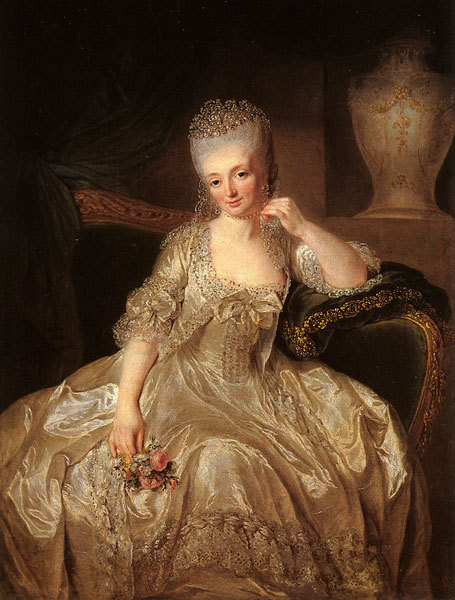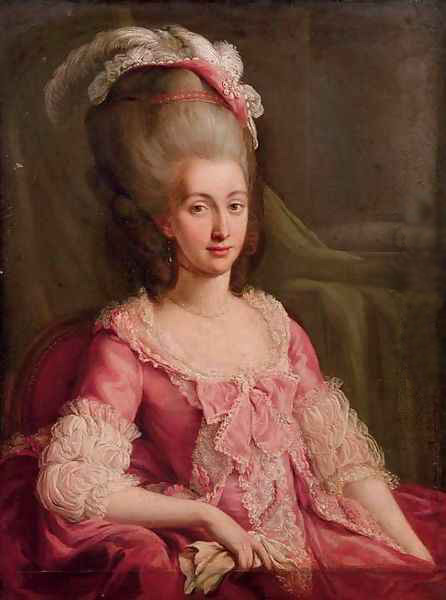It's been a long while since I posted anything but there's something that I've been working on for a month or so. The beginning of this post was written in late October and now I've already finished the dress I'm talking about here. I'm going to write another post with pictures of the whole outfit as soon as I can.
25th of October, 2011
After a couple of weeks of considering what to make out of the new fabric I bought just a while ago, I decided it's going to be a dress that some of you might call "a proper polonaise". For a long time I've been waiting for a chance to make something similar that was worn by Kirsten Dunst in the movie Marie Antoinette (look for photos of the particular dress at the end of this post) so now I've begun with it. The dress is going to be made out of dark purple taffeta - to mention, I've been looking for affordable dark purple taffeta for ages - with a white petticoat. So far I've drawn the pattern and fitted it for a couple of times and the cutting is next up, if lucky, already tomorrow.
25th of October, 2011
After a couple of weeks of considering what to make out of the new fabric I bought just a while ago, I decided it's going to be a dress that some of you might call "a proper polonaise". For a long time I've been waiting for a chance to make something similar that was worn by Kirsten Dunst in the movie Marie Antoinette (look for photos of the particular dress at the end of this post) so now I've begun with it. The dress is going to be made out of dark purple taffeta - to mention, I've been looking for affordable dark purple taffeta for ages - with a white petticoat. So far I've drawn the pattern and fitted it for a couple of times and the cutting is next up, if lucky, already tomorrow.
This is the design I'm dealing with...
First off, some examples of surviving 18th century garments:
Here's a translation to what the museum has to say about this gown:
"Polonaise in striped silk in salmon colour and decorations based on knitting applied to green silk taffeta. The neckline, round in the front and with folded neck. The sleeve, long and tight, closes on the wrist with 5 cylindrical buttons covered with silk thread. The seams are covered with braided cord that finishes at the waist and turns into a hanging cord and tassel. Neck, shoulders and cuffs are done in draped green silk.
This dress, known internationally as “robe à la polonaise”, was called “polonesa” in Spain, and it was fashionable during the reign of Charles III. The most characteristic feature of this dress was the skirt puffed in three parts by means of a sliding cord. The Spanish identity of this polonaise is given by the decorative elements as the draping on the shoulders that hide the shoulder seams."
This dress, known internationally as “robe à la polonaise”, was called “polonesa” in Spain, and it was fashionable during the reign of Charles III. The most characteristic feature of this dress was the skirt puffed in three parts by means of a sliding cord. The Spanish identity of this polonaise is given by the decorative elements as the draping on the shoulders that hide the shoulder seams."
Thanks to my friend who helped me with the translation!
Oringinal: Museo del Traje: Polonesa
Oringinal can be found at: Polonaise dress 1778, MET
Examples of polonaises in paintings:
 |
| Princess Amalie of Preussen (1771) by Anna Dorothea Therbusch. |
 |
| Portrait of an elderly lady with her daughter (1775). |
 |
| Queen Charlotte by Benjamin West, 1776. |
 |
| Unknown Woman (1779) by Jens Juel. |
 |
| Jane, Duchess of Gordon and her Son, the Marquis of Huntly (1778) by George Romney. |
 |
Portrait of the Comtesse d’Artois, Maria Teresa of Savoy (ca. 1780) by an unknown artist.
|
Examples of polonaises in movies:
Seeing this fashion plate was the turning point when I finally decided it's going to be a dress of this sort!














The last dress is also from the Museo de Traje
ReplyDeleteI'm' impatient to see your finished dress
Just found your blog, and I love it! Given that you like the costumer's guide I thought you might like this site: http://www.recycledmoviecostumes.com/
ReplyDeleteHeileen: Thanks for the correction!
ReplyDeleteStarrfade: Oh, I love recycled movie costumes! That's an awesome site, thanks for sharing it!
I'd like to mark a wonderful portrait of Comtesse d'Artois. It's glamorous example of French painting XVIII centuary.I like the Lady's subtle countenance, her rose-madder coloured gown with sleeves covered by airy fabric. In front, on the bossom the gown was trimmed with pompouse bow.Bellow the gown was decorated profusely with white lace. But the essential detail of this portrait is the Lady's unusual tall head-dress crowned by very elegant woman's hat with white feathers. French woman's portraits of XVIII cent.are one of my favourites. Great thanks for sharing this delightful portrait!!!!!
ReplyDelete